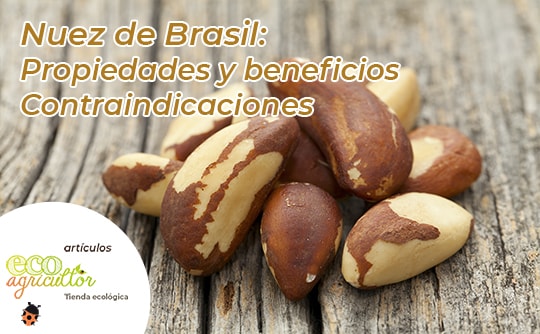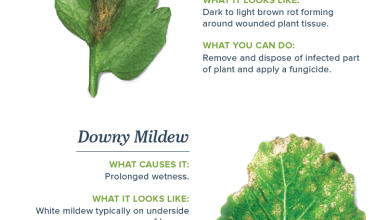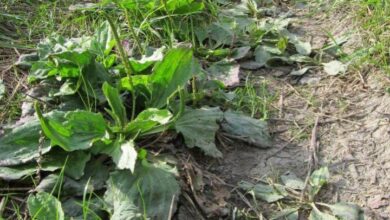Brazil nut: what are its properties, benefits and contraindications

The seed of the Bertholletia exelsa or Barthollesia excelsa , is known as Brazil nut, Amazon nut, Para chestnut, Brazilian coquito, Beni chestnut, Juvía or Sapucaia in the Orinoco and Brazil , and is a food whose demand has spread in the last years.
The Brazil nut belongs to the group of Nuts , like pecans , pistachios , almonds , walnuts , pumpkin seeds , chestnuts or sunflower seeds.
It is a tree, known as chestnut or chestnut tree, native to the tropical rainforest of the Amazon, in South America, which includes the countries of Venezuela, Guyana, Colombia, Peru, Brazil and Bolivia .
It is a species of large proportions, which grows and produces its seeds under natural conditions, fulfilling functions in ecosystems of great importance for their conservation.
These trees, the only species of the genus Bertholletia , of the Lecythidaceae family , are found in groups of up to 100 specimens separated by about 300 meters from each other. With more than 1 meter in diameter, they reach 50 meters in height and can live for more than 1000 years .
Edible seeds are found within a fruit, similar to a coconut , that is produced only in the wild. As it is a self-incompatible species (incapable of producing seeds by self-pollination), pollination is carried out through the intervention of living organisms such as the orchid Coryanthes vasquezii , which attracts some species of bees. .
The fruit matures in 14 months, reaching a diameter of 15 cm, within which are between 8 and 24 seeds of 4 or 5 cm long. A mature tree can produce between 200 and 400 fruits a year .
Harvesting the fruits is quite risky. It is carried out during the rainy season, collecting the fruits that fall from the tree, with the risk of finding a ripe fruit that exceeds one kilo in weight on the path of 80 km / h fall.
On the other hand, a harvest that is too intense would end the sustainability of the tree and the ecosystem, with the loss of many species that use the tree and even the shells of the fruit as shelter. That is why it is important to consider the acquisition of Ecological Brazil nut , a fruit whose responsible production is of fundamental importance in the conservation of the species and the ecosystem.
Nutritional value of the Brazil nut
The Berthellotia excelsa seed is a highly caloric food, due to a high concentration of lipids and proteins , rich in sulfur amino acids, methionine and cysteine.
Proteins constitute 15 to 17% of the weight of the seed when fresh, and almost 50% in the case of flour.
As for the dry seed, as it is generally marketed, the fat content reaches almost 60g / 100g, proteins 14g / 100g and carbohydrates 7g / 100g, with a total contribution of 714 kcal of energy.
The Brazil nut is the natural edible that contains the most selenium , in addition to magnesium, iron, phosphorus and calcium, providing vitamins B1 (thiamine), B2 (riboflavin), Nicotininamide, a-tocopherol and y-Tocopherol.
67% of the fresh seed are monounsaturated and polyunsaturated fats , such as palmitic acid (12-15%), stearic acid (8.7-10.4%), oleic acid (27.2-40%) and linoleic acid (24 to 49%), which have good health effects with anti-inflammatory properties .
Among the minerals, Brazil nuts also contain barium (Ba) and radium (Ra), the levels of which vary as a result of bioaccumulation in the tree.
.
Benefits of its consumption
Because of its high nutritional value, especially in terms of the amount of vegetable proteins , the Brazil nut is recommended in diets for high sports performance.
A notable element of the nutritional contribution is the presence of selenium , which is why it is associated with protection against the development of tumors , particularly in the inhibition of some types of cancer.
Read: Shea butter , natural remedy to regenerate the skin
Selenium (Se) is an essential micronutrient that performs physiological functions in thyroid hormone metabolism . It is part of the peroxidase enzyme, an antioxidant system that prevents the formation of free radicals, improving the functions of the immune system and preventing premature aging, as well as various diseases . .
In the Brazil nut, selenium is bound in its proteins selenomethionine and selenocystine, while, with the presence of tocopherols such as vitamin E , they help maintain good health by influencing various functions of the body.
Selenium, through selenoproteins, plays a key role in the ability of intestinal epithelial cells to respond to microbial oxidation challenges as a protector of the gastrointestinal tract .
For its part, the addition of linolenic acid or omega-6, in addition to anti-inflammatory properties, performs functions in heart health , modifying and decreasing low-density lipoproteins (LDL), total cholesterol (CL) and triglycerides (TG). .
Brazil nuts balance the fat content with a healthy supply of insoluble fiber and phytosterols , helping to eliminate cholesterol. At the same time, fiber contributes to a feeling of fullness and improves intestinal function .
It is also a fruit rich in magnesium , which helps to improve and maintain the health of the heart muscle, intervening in contraction and relaxation, acting on cardiovascular problems such as hypertension .

Protecting cells from the action of free radicals, along with anti-inflammatory properties, Brazil nuts contribute to :
- Maintain healthy vision
- Lower cholesterol
- Reduce the risk of cardiovascular disease
- Regulate hormone levels
- Protect and maintain skin health
- Prevent cancer of the prostate, breast, liver and lung (for their antioxidant activity and antiproliferative effects)
Some studies have shown that the intake of 100 μg / day (micrograms per day) of selenium (equivalent to 1-2 Brazil nuts) for 3 months, increases the concentrations of selenium in plasma, which suggests the possibility of reducing the risk of developing chronic diseases by increasing the body’s ability to regulate hormone levels .
In traditional indigenous medicine it is attributed diuretic properties and as an external topical for ear disorders, prepared in milk or hot water. In addition, from the bark they obtain an infusion to treat inflammation, liver and rheumatic diseases and hypertension.
Contraindications of Brazil nuts
The Brazil nut is the natural food for which the highest radioactivity is recognized. Due to the tree’s extremely extensive underground root system, the fruits have two elements with radioactive potential: barium (Ba) and radium (Ra).
One serving can contain 26 mg of barium, of which 90% is retained in the body. Too much barium can cause gastroenteritis, muscle paralysis, and ventricular rhythm disorders.
For its part, the accumulation of radium in the body can also have adverse effects on health.
Hence the importance of strictly following a serving of between 1 and 2 Brazil nuts daily or at sporadic intervals to ensure safe consumption and take advantage of the benefits.
How to consume Brazil nuts
The seed called Brazil nut is consumed raw, roasted, salted, alone or as an ingredient in sweet preparations or confectionery products.
Locally, where fresh seeds are obtained, they are crushed to obtain what is known as chestnut milk , used in typical dishes of Peru and Bolivia, as well as for the treatment of spots on the skin .
One of the most widespread products is Brazil nut oil , which is obtained from dehydrated chestnuts and has a good digestibility coefficient.
The flour Brazil nut , is obtained from the residue of oil extraction. This flour can be mixed with wheat flour to make bread or other foods.
On the other hand, the non-marketable oil is used, for the production of soaps , and the peels, for the energy of the drying ovens.
Sources:
- «The Bertholletia excelsa . An extraordinary plant ”, Dr. José Osvaldo Kindelán Barrientos, Msc. Nutrition in Public Health, and Lic. Yuria Isabel Caraballo Sánchez, Msc. Entomology. Symposium «Immunology, nutrition, selenium, antioxidation and health», Havana. Updated 2015.
- «Physical-chemical stability of dehydrated chestnut seeds (Bertholletia excelsa)», Victor Sotero, Ursula Monteiro, Claudia Merino-Zegarra, Martha Maco, Ericka Davila and Dora García. Research Institute of the Peruvian Amazon. 2011
- “ Brazil nut production ( Bertholletia excelsa ) in the context of timber extraction in Madre de Dios, Peru. Implications for promoting integrated forest management ”, Manuel R. Guariguata and Cara A. Rockwell. 2015.
- «Preliminary studies of the chemical characterization of fatty acids of Bertholletia excelsa fruit oil by gas chromatography», Ivan Limachi, Oscar Farfan, Olov Sterner, Alberto Giménez Turba. Universidad Mayor de San Andrés, Bolivia. Biofarbo. 2009
- “Organic agriculture in the Tropics and Subtropics. 18 crop guides. Chestnut ”, Natureland Association. 2000
- «National Commission against Biopiracy: Chestnut», Year 4, N ° 12 December 2018
- “Supplementation with Brazilian nuts and green tea extract regulates targeted biomarkers related to colorectal cancer risk in humans”, Ying Hu, Graeme H. Melntosh, Richard K. Le Leu, Roshini Somashekar, Xing Q. Meng, Geetha Gopalsamy, Libby Bambaca, Ross A. McKinnon and Graeme P. Young. British Journal of Nutrition. 2016
- “Properties of Brazil nuts: A review”, Ariane Mendonça Kluczkovski, Maristela Martins, Silmara Miranda Mundim, Renata Hanan Simões, Karine Silveira Nascimento, Helyde Albuquerque Maricho and Augusto Kluczkovskij Unior. African Journal of biotechnology. 2015.
- «Brazil nuts and associated health benefits: A review», Jun Yang. Food Science and Technology, Elsevier. 2009




